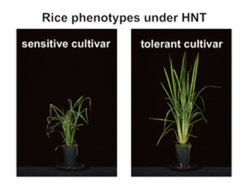Natural Genetic Diversity and Molecular Mechanisms of High Night Temperature Tolerance in Rice
Global warming has an increasing influence on the productivity of crop plants. In the past century a stronger increase in daily minimum compared to maximum temperatures suggests an asymmetric global warming. However, only a few studies have so far investigated the influence of high night temperatures (HNT) on crop physiology.

Figure: Rice plants were grown in a controlled climate chamber and differentr cultivars were subjected to high night temperatures (HNT, 28°C) for several weeks. While tolerant cultivars continued to grow normally, sensitive cultivars showed leaf damage in the form of chlorosis and necrosis.
We are analysing the effects of HNT on different rice cultivars. A clear distinction between tolerant and sensitive cultivars was found based on leaf chlorosis estimates. HNT also results in a high degree of flower sterility and subsequent reduction in grain yield. We are investigating the molecular consequences of HNT and the basis of the varying tolerance using a wide range of physiological approaches in addition to metabolite, enzyme activity and gene expression profiling. In addition, we are using quantitative trait locus (QTL) mapping to identify genomic regions of rice that are responsible for HNT tolerance in particular cultivars.
